11.12 EXERCISES
Preliminary Questions
Question 11.207
Polar coordinates are suited to finding the area (choose one):
- (a) Under a curve between \(x = a\) and \(x = b\).
- (b) Bounded by a curve and two rays through the origin.
Question 11.208
Is the formula for area in polar coordinates valid if \(f(\theta)\) takes negative values?
Question 11.209
The horizontal line \(y=1\) has polar equation \(r=\csc\theta\). Which area is represented by the integral \(\frac12\int_{\pi/6}^{\pi/2} \csc^2\theta\ d\theta\) (Figure 11.73)?
- (a) \(\square ABCD\)
- (b) \(\triangle ABC\)
- (c) \(\triangle ACD\)
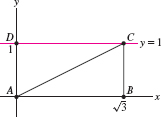
Exercises
Question 11.210
Sketch the area bounded by the circle \(r = 5\) and the rays \(\theta = \frac{\pi}{2}\) and \(\theta = \pi\), and compute its area as an integral in polar coordinates.
Question 11.211
Sketch the region bounded by the line \(r=\sec\theta\) and the rays \(\theta = 0\) and \(\theta = \frac{\pi}3\). Compute its area in two ways: as an integral in polar coordinates and using geometry.
Question 11.212
Calculate the area of the circle \(r = 4\sin\theta\) as an integral in polar coordinates (see Figure 11.65). Be careful to choose the correct limits of integration.
Question 11.213
Find the area of the shaded triangle in Figure 11.74 as an integral in polar coordinates. Then find the rectangular coordinates of \(P\) and \(Q\) and compute the area via geometry.
639
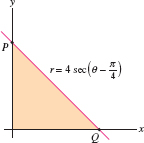
Question 11.214
Find the area of the shaded region in Figure 11.75. Note that \(\theta\) varies from \(0\) to \(\frac{\pi}2\).
Question 11.215
Which interval of \(\theta\)-values corresponds to the the shaded region in Figure 11.76? Find the area of the region.


Question 11.216
Find the total area enclosed by the cardioid in Figure 11.77.
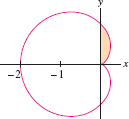
Question 11.217
Find the area of the shaded region in Figure 11.77.
Question 11.218
Find the area of one leaf of the “four-petaled rose” \(r = \sin 2\theta\) (Figure 11.78). Then prove that the total area of the rose is equal to one-half the area of the circumscribed circle.
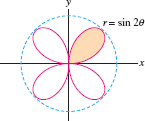
Question 11.219
Find the area enclosed by one loop of the lemniscate with equation \(r^2=\cos 2\theta\) (Figure 11.79). Choose your limits of integration carefully.

Question 11.220
Sketch the spiral \(r = \theta\) for \(0\le \theta\le 2\pi\) and find the area bounded by the curve and the first quadrant.
Question 11.221
Find the area of the intersection of the circles \(r=\sin\theta\) and \(r=\cos\theta\).
Question 11.222
Find the area of region \(A\) in Figure 11.80.
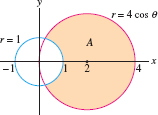
Question 11.223
Find the area of the shaded region in Figure 11.81, enclosed by the circle \(r=\frac12\) and a petal of the curve \(r=\cos3\theta\). Hint: Compute the area of both the petal and the region inside the petal and outside the circle.

Question 11.224
Find the area of the inner loop of the limaçon with polar equation \(r = 2\cos\theta - 1\) (Figure 11.82).
640
Question 11.225
Find the area of the shaded region in Figure 11.82 between the inner and outer loop of the limaçon \(r = 2\cos\theta-1\).
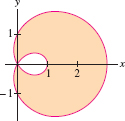
Question 11.226
Find the area of the part of the circle \(r = \sin\theta+\cos\theta\) in the fourth quadrant (see Exercise 26 in Section 11.3).
Question 11.227
Find the area of the region inside the circle \(r = 2\sin\big(\theta+\frac{\pi}4\big)\) and above the line \(r = \sec\big(\theta-\frac{\pi}4\big)\).
Question 11.228
Find the area between the two curves in Figure 11.83.
Question 11.229
Find the area between the two curves in Figure 11.83.

Question 11.230
Find the area inside both curves in Figure 11.84.
Question 11.231
Find the area of the region that lies inside one but not both of the curves in Figure 11.84.

Question 11.232
Calculate the total length of the circle \(r = 4\sin\theta \) as an integral in polar coordinates.
Question 11.233
Sketch the segment \(r = \sec\theta\) for \(0\le \theta\le A\). Then compute its length in two ways: as an integral in polar coordinates and using trigonometry.
In Exercises 25–30, compute the length of the polar curve.
Question 11.234
The length of \(r = \theta^2\) for \(0\le \theta\le \pi\)
Question 11.235
The spiral \(r = \theta\) for \(0\le \theta\le A\)
Question 11.236
The equiangular spiral \(r = e^\theta\) for \(0 \le \theta\le 2\pi\)
Question 11.237
The inner loop of \(r = 2\cos\theta-1\) in Figure 11.82
Question 11.238
The cardioid \(r = 1-\cos\theta\) in Figure 11.77
Question 11.239
\(r = \cos^2\theta\)
In Exercises 31 and 32, express the length of the curve as an integral but do not evaluate it.
Question 11.240
\(r = (2-\cos\theta)^{-1}\),\(\quad\)\(0\le \theta\le 2\pi\)
Question 11.241
\(r = \sin^3t\),\(\quad\)\(0\le \theta\le 2\pi\)
In Exercises 33–36, use a computer algebra system to calculate the total length to two decimal places.
Question 11.242
![]() The three-petal rose \(r=\cos3\theta\)
in Figure 11.81
The three-petal rose \(r=\cos3\theta\)
in Figure 11.81
Question 11.243
![]() The curve \(r=2+\sin 2\theta\)
in Figure 11.84
The curve \(r=2+\sin 2\theta\)
in Figure 11.84
Question 11.244
![]() The curve \(r=\theta \sin\theta\)
in Figure 11.85 for \(0\le \theta\le 4\pi\)
The curve \(r=\theta \sin\theta\)
in Figure 11.85 for \(0\le \theta\le 4\pi\)
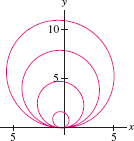
Question 11.245
![]() \(r= \sqrt{\theta}\),\(\quad\)\(0\le\theta\le 4\pi\)
\(r= \sqrt{\theta}\),\(\quad\)\(0\le\theta\le 4\pi\)
Further Insights and Challenges
Question 11.246
Suppose that the polar coordinates of a moving particle at time \(t\) are \((r(t),\theta(t))\). Prove that the particle's speed is equal to \(\sqrt{(dr/dt)^2 + r^2 (d\theta/dt)^2}\).
Question 11.247
![]() Compute the speed at time \(t=1\) of a particle whose polar
coordinates at time \(t\) are \(r= t\), \(\theta = t\) (use Exercise
37). What would the speed be if the
particle's rectangular coordinates were \(x=t, y=t\)? Why is the
speed increasing in one case and constant in the other?
Compute the speed at time \(t=1\) of a particle whose polar
coordinates at time \(t\) are \(r= t\), \(\theta = t\) (use Exercise
37). What would the speed be if the
particle's rectangular coordinates were \(x=t, y=t\)? Why is the
speed increasing in one case and constant in the other?